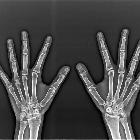Arachnodaktylie
Arachnodactyly refers to the physical finding of elongated, thin "spider-like" fingers, which are a classic feature of Marfan disease, but by no means pathognomonic .
Radiographic features
The metacarpal index was historically-used as a radiographic criterion for arachnodactyly. To obtain it, the length of the second, third, fourth and fifth metacarpals is divided by their width at the mid shaft. An index of greater than 8.4 is considered the upper limit of normal . It is no longer used due to its poor specificity and sensitivity.
History and etymology
From the Ancient Greek "arachno" refers to spiders and "dactyly" means fingers.
Differential diagnosis
- other hereditary diseases of connective tissue
Siehe auch:
- Ehlers-Danlos syndrome
- Marfan-Syndrom
- Loeys-Dietz-Syndrom
- Kongenitale Kontrakturale Arachnodaktylie
- Multiple endokrine Neoplasie
- Galloway-Syndrom
- Homozystinurie
- Van-den-Ende-Gupta-Syndrom
- Cytochrom-POR-Mangel
- Bainbridge-Ropers-Syndrom
- Al-Gazali-al-Talabani-Syndrom
- Blindheit-Skoliose-Arachnodaktylie-Syndrom
- Marden-Walker-Syndrom
- Kosztolanyi-Syndrom
- Die-Smulders-Vles-Fryns-Syndrom
- Haim-Munk-Syndrom
- Van Benthem-Driessen-Hanveld-Syndrom
und weiter:
 Assoziationen und Differentialdiagnosen zu Arachnodaktylie:
Assoziationen und Differentialdiagnosen zu Arachnodaktylie:







